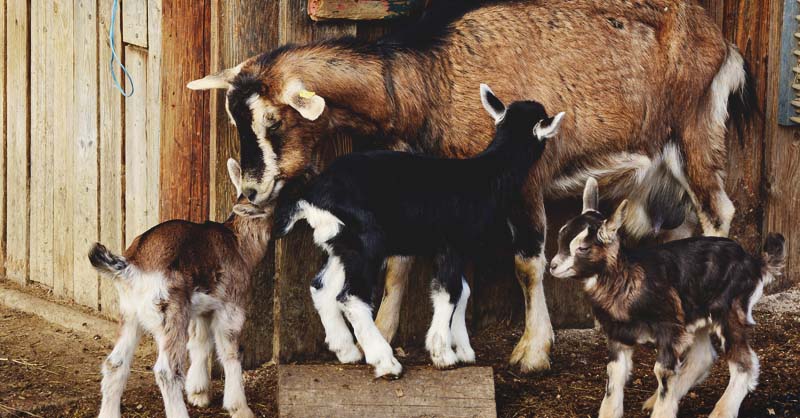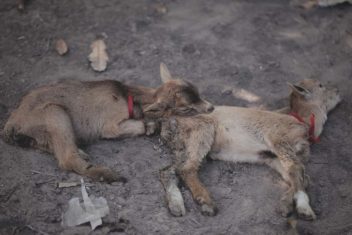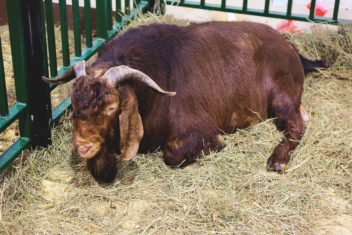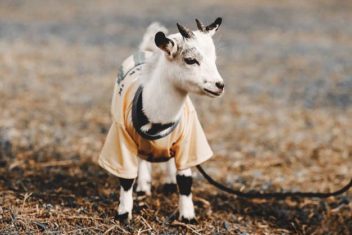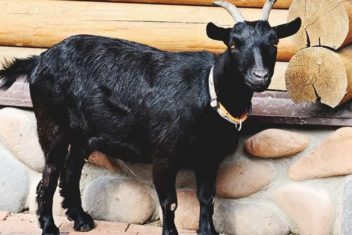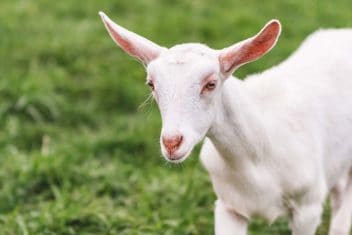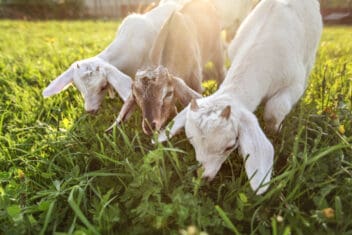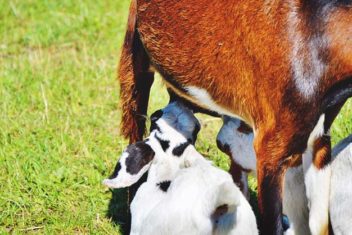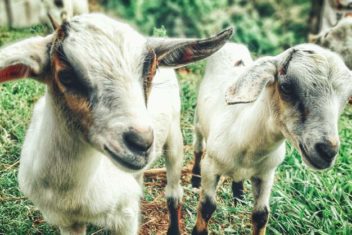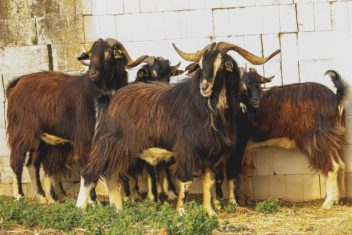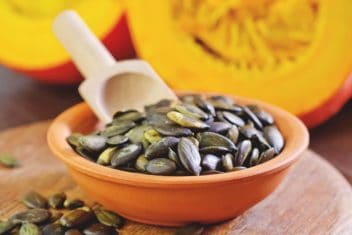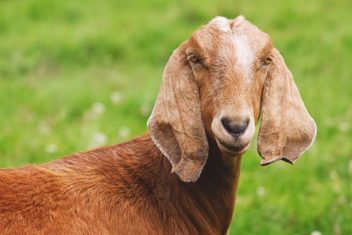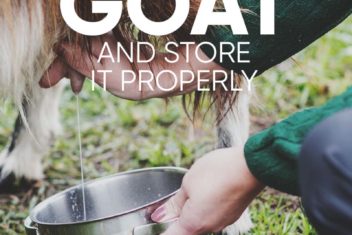I love this time of year. Spring is in the air; my garden is starting to look like a garden again. Plus, my goats are becoming hormonal, nasty, biting brats to each other. They are butting heads over non-existent offenses, bossing each other around, eating each others’ beards… Oh, what fun!
Seriously, when my goats start acting like that word that begins with a B, and shouldn’t be used on public websites, I know that kidding season is right around the corner. So, while I don’t actually enjoy the hormonal moodiness that comes with late-term pregnancy, I am super excited about goat babies.
When the bad behavior starts, that’s my cue to physically and mentally prepare for hard labor. Now, technically, it’s my does who have to do the ‘hard labor’ to deliver their babies. But, there’s some labor I have to go through to get ready as well.
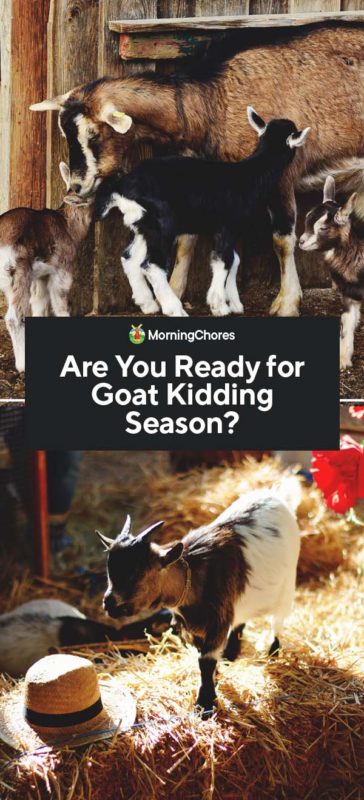
A Room of Their Own?
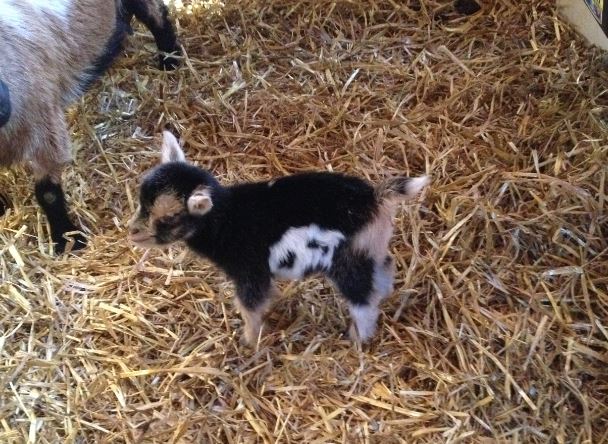
I’ve seen lots of lists on the pros and cons of isolating goats before and after labor. There are good arguments on both sides.
Personally, though, I let my does decide for me. Some does need isolation, while some don’t. Their behavior tells me what needs to be done.
So, ideally, even if you prefer open barn births, there are several reasons why you should consider preparing a separate space that is sufficient to keep pregnant does and their babies apart from the herd for a while.
– Solitary Confinement
As does get closer to giving birth, they get a lot more territorial. Some are only mildly irritated by the presence of other goats. They may nip and nudge a bit. But otherwise, they just seem more aloof toward their fellow herd mates.
The “divas” though, they are a different story. One of my divas will have bloody battles to keep other goats way from areas she deems worthy for kidding. This usually starts two days before actual labor.
To keep the peace in my herd and save my divas from themselves, I lock them up. It’s only temporary, of course. Until they come back from that hormonal-driven crazy place, though, I separate them from the rest of the herd.
– Protection
On the other side of the spectrum, some goats are low on the pecking order. They are prone to bullying and general meanness from their herd mates.
Sometimes these less dominant does need protection during labor. Offering them a quiet, isolated place to do the deed ensures their safety and that of their kids when they are most vulnerable.
– Room to Bond
Just like with humans, some new does are natural mothers. Others need a little while to figure it out.
If you let a not-so-natural doe and her kids run with the herd, that doe is more likely to neglect her newborn. When you isolate them with their kids, their kids become their herd.
With a little encouragement from you and some time alone to bond with their babies, new moms usually catch on within a few days.
– The Kid Pen
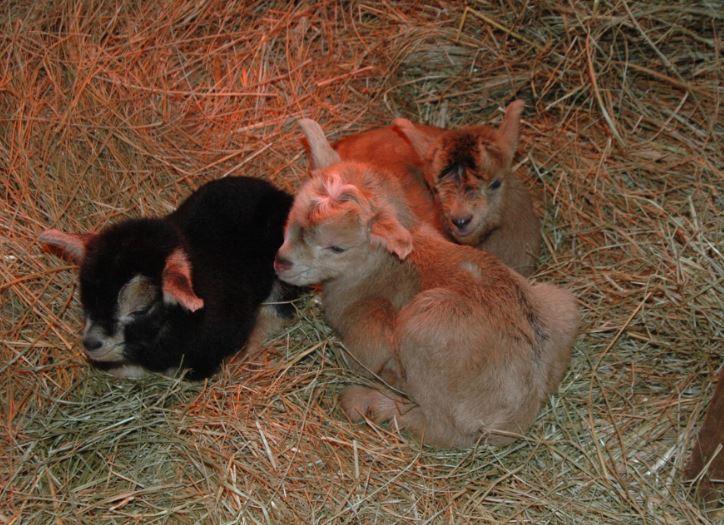
If you plan to bottle raise your kids, then you will probably need a place to keep kids to train them to nurse on the bottle. Some people raise kids entirely separate from their moms. Others will separate them only for feeding times.
If you go the entirely separate route, then you need a separate room or stall for them to stay in. Plus, you also need a way to let them graze away from the rest of the herd. You can do this by scheduling grazing times or having different pastures for kids.
Others take a more moderate approach. They confine kids until they milk the does. Then, they feed the kids. After that, since the does are milked and the kids are fed, they’ll let them mix on pasture.
The kids may nurse on the does a bit. But that usually only increases milk production. Since it triggers the does bodies to want to make more milk, overall milk quantity increases.
– The Brooder
Until baby goats gain a bit of weight and start eating pasture, they have very little muscle and no fat. That means they have no built-in insulation against the cold.
Also, once goats start eating on pasture, fermentation takes place in their digestive systems. This process
As such, similar to raising baby chicks or ducklings, in cold climates, baby goats may need a heated space too. They usually don’t need it for very long. But it’s much easier (and less of a fire risk) to warm an area for small kids than your entire herd.
Note: If you need a brooder area for baby goats, then you might also need a blow drier to dry them off quickly after they are born.
Cleanliness and Comfort
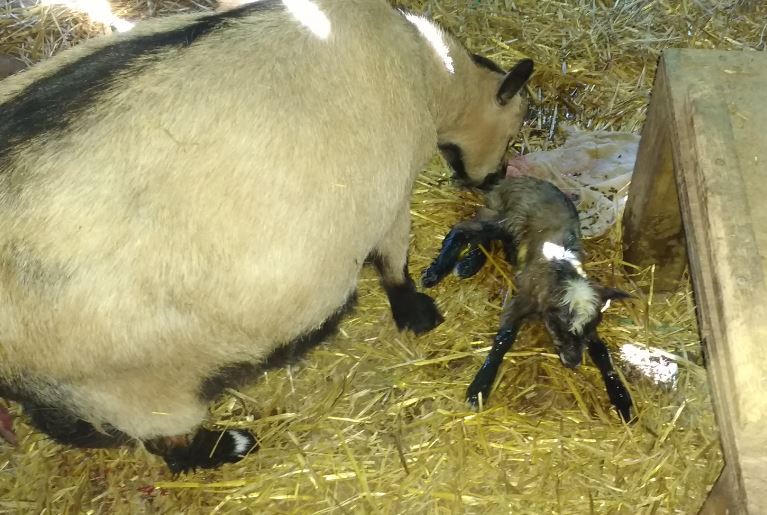
I know that goats don’t need the same level of hygiene as humans do. In fact, humans wouldn’t need the level of hygiene we think we do if we’d play in the dirt more.
Still, when it comes to having babies, goat or otherwise, a certain amount of cleanliness and order will make the process more comfortable and less risky.
– Ready the Barn
For me, when kids are coming, that means it’s time to clean the barn. A little contact with less than perfectly clean litter helps build kid immune systems. But, too much, too fast can be overload.
Just like protecting baby chicks from coccidiosis by exposing them to dirt slowly, limiting contact with dirty litter at the outset promotes good health. So, I start by cleaning out all the old litter. Then, for the first week or so, I apply fresh bedding twice daily to keep it clean.
After that, when babies are eating hay, pasture, and pellets in addition to drinking milk, then I ease back into my regular level of hygiene.
– Ready the Waiting Room
Since you’ll likely be in the kidding room making sure things go well, you also want to get that space ready for your comfort. I clean off the table in my kidding area. I bring in a
I also like to wipe out all the cobwebs and wasp nests to make the place a bit more human hospitable during kidding season. Then, I set out a few old magazines, a box of tissue, and cue the elevator music. (Yes, I’m just kidding about the music!)
If you don’t want to miss a birth, then you may also want to set up a monitor so you can hear or see what’s going on in the barn while you are working in other locations.
Staple Supplies
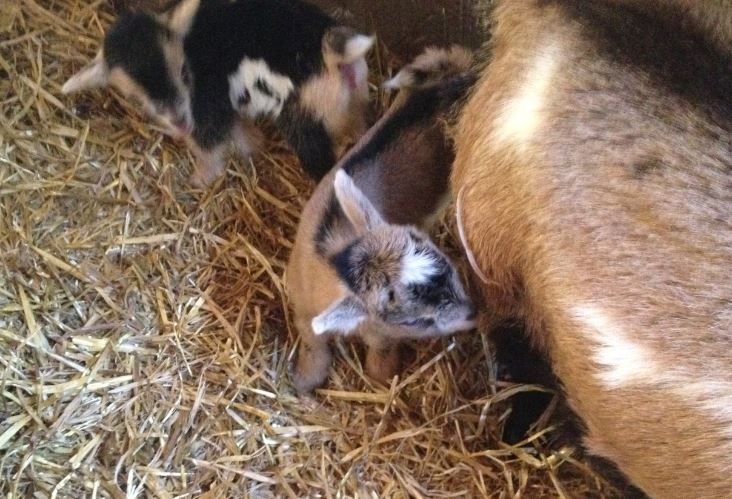
In general, I am about as low maintenance as it gets on the supplies I use for goat births. Most of what I use is stuff I have on hand already for general homestead first aid and other activities.
That said, there are a few things I gather up prior to births just in case I need them.
1. Ready the Bottles
Even if you don’t plan to bottle feed your babies, you should be ready to. Does will sometimes reject kids. Kids can be slow to nurse. Does that suffer trauma during labor may not be up to feeding their kids right away.
In other words, there’s no guarantee that things will go perfectly during labor or post-labor. Being ready with clean bottles is important.
Regular baby bottles work for emergency feeding. But, bottles designed for goats are better for long-term use.
2. Have Towels Handy
Does will clean their kids… if they have time and energy. But when it’s cold, they have multiple kids, or if labor is protracted, they might not get to it quickly enough on their own.
Being ready with towels so you can jump in and help clean newborns is really important. Focus on their face and ears first, then the
3. Repurpose Your Feed Bags
After cleaning the kid’s faces and getting the brunt of the goop off of them, I like to let the mom’s do most of the rest of the cleaning. (Well, that is as long as it’s warm and the kids aren’t at risk for hypothermia.)
So, I like to keep a few empty paper feed bags around to set under the kids to prevent them from getting coated in straw until they are clean. Then, to clean up, I collect the bags and compost them.
Cardboard works well for this too. Plastic feed bags also work, but they’re not compostable.
4. Stockpile Litter
I go through a lot more litter when kids are around. So, I load up on fresh straw shortly before kidding starts.
It’s not always easy to control the quality of your straw. But when I find tight bales that are low on dust, I set aside a few extra specifically for kidding season.
5. The “Go In and Get ’em” Kit
Last year, I had a string of mal-positioned kids. This problem was weather-related. Our insane rain kept the goats off pasture a lot. So they lived on hay, goat pellets, and free choice mineral supplements.
Turned out those feedstocks produced overly large kids who were also prone to muscle disease from selenium deficiency. Now, my conditions were totally abnormal and hopefully, I never have to do that much work again.
Still, there’s always a chance that you’ll have to assist in a delivery. Being ready with your “kit” can cut down your stress when you are in the middle of challenges. These are the things I found useful:
Clean Rope: Use this as a sling to hook around the head and turn the baby.
Disposable Gloves: To cut down the risk of infection while reaching inside your goat.
Water-Soluble Lubricant: For coating the gloves for easy entry.
Disinfectant: Iodine, alcohol, or hydrogen peroxide can all be used as needed for disinfection. Iodine is typically preferred since there is no burn or fizz and it’s obvious to see where you’ve used it.
Sharp Short Knife: For use if dissection is necessary to remove the fetus.
Suture Kit: For postnatal care
Many, experienced goat keepers all have their own methods and brand preferences for their birthing kits. Personally, I use what I have around already. So, I can’t make specific brand recommendations. However, keeping things as clean as possible will reduce the risk of post-birth complications.
Except for the knife, which I clean, the other tools I use are all new, sterile, and stored in containers that prevent pre-use contamination. Generally, sealable plastic bags are my go-to for sterile storage.
6. Post-Natal Care
Labor is rough on does. Being born is also quite a stressful event for those little kids. Sometimes even if they get through it without incident, they may need help shortly after. Things like nutrient drenches, feeding syringes, and vitamin supplements may be necessary.
De-wormer is also something to consider. Many goat keepers de-worm a month before due dates and then again afterward. I only de-worm if my doe seems at risk (e.g., signs of anemia or poor body condition).
Personally, though, after last year’s complications, I now stay stocked on BO-SE (selenium supplement) and syringes for my does and kids. I also keep copper boluses for my does. Talk to your vet or another experienced goat keeper in your area about post-natal vitamin supplements.
I also feed my goats lots of alfalfa pellets before and after labor. Alfalfa is a treat they love. However, it also supplies calcium to ratchet up milk production and make up for any labor-related calcium deficiencies.
7. Emergency Kid Feed

Now, I certainly hope never to need it. But, I have colostrum saved from other goat births in the freezer. I also have a back-up supply of raw milk ready if I lose a doe in labor.
If this is your first time through goat labor, you won’t have an arsenal of frozen kid feed. So, you may want to have some powdered colostrum on hand as a precaution. The kids will drink colostrum for about the first 24 hours or so before they can be transitioned to milk.
On the milk front, you can use milk replacer to keep baby goats alive. But, if you can find fresh, raw milk from disease-free goats that’s usually a better form of nutrition until goats can be weaned.
8. Bottle of Champagne
This one is optional of course. But, given all this work we do to take great care of our does and kids, I do feel like we also deserve a treat for our efforts.
Final Encouragement
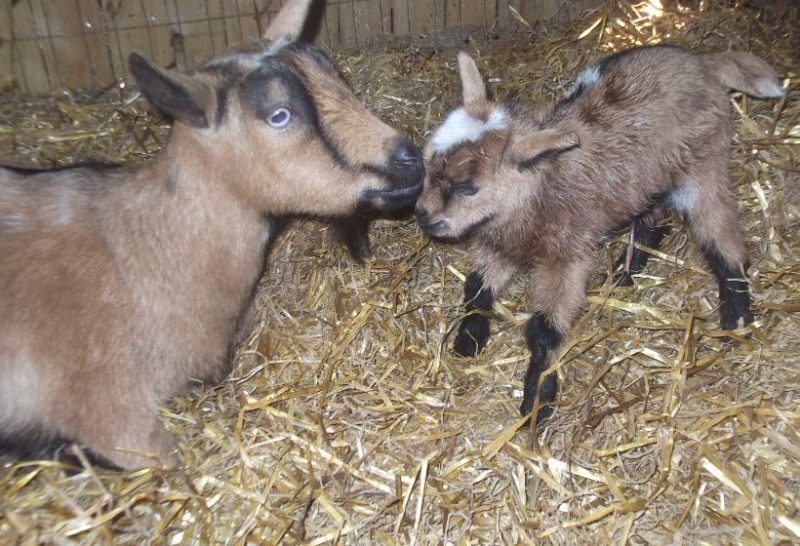
When you work with livestock, you will inevitably face death more than you want to. It’s part of the process. In my opinion, though, getting to bear witness to the beauty of birth, the continuity of life, and the wonder of nature are gifts that far outweigh the hardships.
Take time to understand the process, learn from your goats, face your mistakes, and improve your processes each year. Also, remember, whether your births go smooth or you have challenges, the fact that you are doing your best to be a good steward to your goats should always be celebrated.
Now, burst open that bubbly I suggested and celebrate the kidding season in style!

